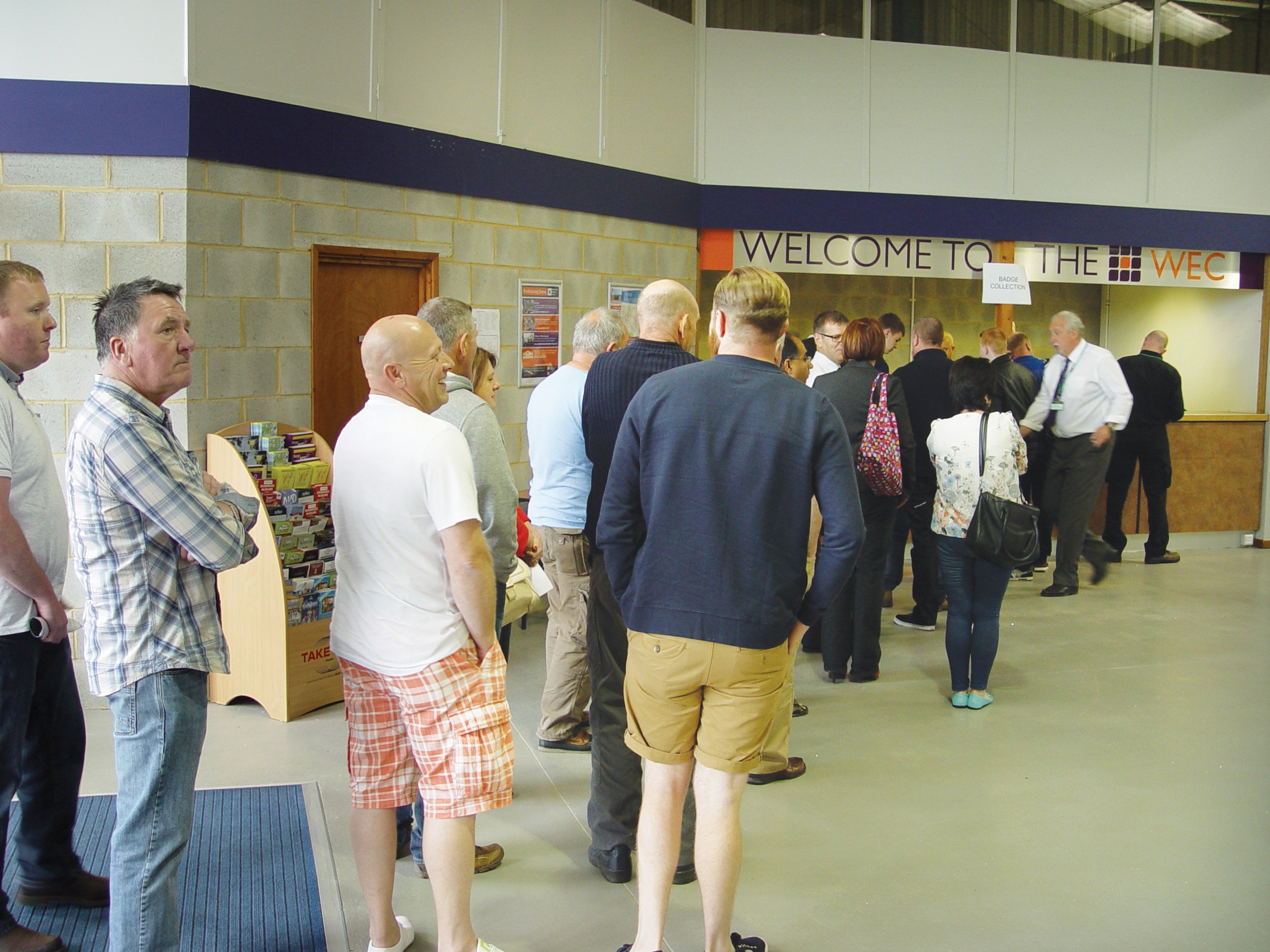Report : Memorials 2016
Memorial masonry organisations MAB and NAMM have joined forces to present a briefing paper to local and central government to try to persuade councils not to sell memorials. Meanwhile, NAMM prepares for its second stand-alone Tradex exhibition.
There’s good news and there’s bad news on the memorial side of the stone industry. The good news is that NAMM will be holding its second memorial-only exhibition in Warwickshire next year following the success of the first last year. The bad news is that the threat from local authorities selling memorials still hangs over the sector.
Let’s start with the good news.
There was just about universal approval from exhibitors and visitors for NAMM’s stand-alone Tradex memorial exhibition held at Warwickshire Exhibition Centre (WEC) this time last year. Many of the exhibitors, plus a few more, will be back again for the next show next year.
Phil Potts, the chief executive officer of NAMM (National Association of Memorial Masons), said during last year’s exhibition that the next event would be after either one year or three years, in order to avoid clashing with the National Funeral Exhibition (NFE) at nearby Stoneleigh.
The conflict is that plenty of funeral directors have their own memorial departments and might not be prepared to attend two shows in quick succession.
None of the memorial wholesalers wanted an annual show so there was never going to be an exhibition this year but in the end NAMM has decided that clashing with NFE is better than losing the momentum of its first stand-alone show in 14 years by waiting three years to stage the next one.
So the next show will be Tradex 2017, this time on Thursday and Friday (rather than Friday and Saturday) 15 & 16 June, once again a week after the National Funeral Exhibition.
Tradex will return to Warwickshire Exhibition Centre, which was an inspired choice of venue. It is a comfortable size for the industry and relatively inexpensive for exhibitors with no exorbitant hidden extras slapped on by contractors for every minor alteration to what’s been agreed. The exhibitors said they actually felt as if they were being welcomed by Meridienne Exhibitions Ltd, which runs the venue.
WEC is centrally located in England, near enough to Coventry for plenty of hotel accommodation but far enough away to have ample free (yes, FREE!) parking to accommodate everyone who wants to attend.
Tradex 2015 had 34 exhibitors, mostly inside, although Stonehealth demonstrated its Doff steam stone cleaning system outside and Hartwell Abingdon Transit Centre showed its vehicles outside. A good proportion of those who exhibited are intending to be back for Tradex 2017. There are also an additional eight stand places to accommodate others.
NAMM says there were more than 500 visitors during the two days of the show last year from 247 memorial masonry companies, which is a sizeable proportion of the industry.
Feedback from visitors and exhibitors alike was extremely positive, most of them delighted that the industry is staging its own, dedicated exhibition again.
A year later, some of the exhibitors say that from a purely commercial point of view the sector does not have the potential for enough extra sales to make exhibiting strictly worthwhile. But most plan to exhibit again next year anyway. Some are concerned that if they do not exhibit they could lose out to competitors but mostly they simply like the idea of the sector having its own showcase.
What many like is that it gives them the opportunity to show more of their skills in unusual memorials to try to encourage the retail side to increase the value of each sale. Cerrig, for example, was showing a new range of memorials in British stone. Director Hugo Were says: “Whether 100 people or 10,000 people turn up, some of them will be interested in our products.”
And Graeme Robertson from A&J Robertson (Granite) in Scotland, says of last year’s exhibition: “We felt busy and well received. We enjoyed it and are keen to go back again.”
Just about everyone was of the same opinion, which is why NAMM did not want a three-year gap to te next show.
There is, though, some concern among some of the memorial wholesalers about the show’s timing. They think producing new designs for a new catalogue every three years is often enough. No doubt there will be more discussion about the frequency after Tradex 2017.
That’s the good news. Now for the bad news. NAMM has had plenty on its plate with the continuing and possibly growing threat of local authorities selling memorials.
This has been a contentious issue for decades. Local authorities got the taste for selling granite memorials with plaques, urns and columbaria. Some memorial masons objected but there was never a concerted effort to fight the practice.
When local authorities started selling lawn memorials, NAMM stepped in. It employed a barrister to write a ‘stance position’ and managed to curtail all local authority attempts to move into the market until the rules were changed with the passing into law of the Localism Act in 2011.
That seems to allow local authorities to set up in competition to any local business they want to, although the Act does say they either have to do it as a non-profit service or as a separate business subject to the same rules and taxes as any business. The idea of the Act is supposed to be to offset cuts in the amount of money given to councils by central government and make councils more responsive to the requirements of local ratepayers.
A good enough aim, but it is hard to believe that allowing councils to wipe out local SMEs (small firms) was an intended consequence of this Conservative Act of Parliament. On the other hand, MPs have shown no inclination to reconsider the consequences of the Act or even accept them, in spite of repeated approaches from memorial masons (and others) and two presentations in the Houses of Parliaments by MAB and NAMM (attended by hardly any MPs).
The Government is even paying North East Lincolnshire Council, which is leading the way in selling memorials, to tell others how to go about it. The money is coming from a £1million fund the government has established to promote the use of the Localism Act by local authorities.
NAMM and MAB (Memorial Awareness Board) fear that the demise of businesses will be the consequence if councils start selling memorials big-time.
If companies are put out of business, the councils will be left with a monopoly and will find it impossible to resist the temptation to charge monopoly prices. Without competition, innovation and diversity of products also tends to suffer. The consumer loses out all round.
So far, not many councils are selling memorials, although there are burial authorities in London and Liverpool doing so as well as North East Lincolnshire. The issue will be part of the discussion at a conference called ‘Tackling Funeral Poverty’ being organised by ICCM, an organisation of burial authorities, later this month (29 June).
North East Lincolnshire has said it is investigating the possibility of selling funerals and other death care services as well as memorials. The conference will consider whether councils should and could provide all funeral services.
Funerals are a considerably larger part of death care than memorials, with the potential to provide a much greater contribution to the incomes of local authorities and consequently a much greater loss of income to private enterprise – private enterprise that currently contributes significantly to local authority income through business rates and charges.
During the past decade the price of a basic funeral has increased 88% to £3,702, according to the Money Advice Service. It is estimated that in 20 years’ time a funeral might typically cost more than £14,000.
It is not difficult to see how councils can use the cost of funerals and memorials to justify taking over death care services in order to alleviate so-called ‘funeral poverty’.
Most memorial masons and funeral directors are fairly dismissive of the threat from local authorities because they do not face it. Yet. They also think councils that try it will discover it is not as easy as they think it will be and will give up.
Certainly North East Lincolnshire is not a shining example of a service provider.
If there is anything about the service on the council’s website, NSS could not find it.
When we called the main switchboard, the first hurdle to overcome is an incessant wait listening to a looped recording about your call being important to the council, interrupted only by another recorded message telling you what position you are in the queue of calls.
When the ’phone was finally answered, the person at the ‘Customer Access Point’ did not know if the council sells memorials or not. She provided a number for the cremations and cemeteries service. The person who answered the ’phone there did not know, either. Apparently the only person who knew was ‘Dan’, who would call back. When? Maybe tomorrow. Nobody asked if someone had died or if we needed any other death care services, yet as far as they knew we were a customer, or at least a potential one. The only information requested by the person who answered the ’phone was a name and telephone number so ‘Dan’ could call back. He still had not called a week later.
Local authorities are not known for their customer service – not in a good sense, anyway. Nevertheless, as Phil Potts, NAMM’s Executive Officer, says, if a major authority really goes for it, it could quickly become a game changer, not least because smaller authorities tend to take their lead from larger ones. The practice could quickly spread.
That is why NAMM has joined with MAB to commission a ‘briefing paper’ for councils and MPs that has been prepared by a London Public Affairs company called Keene Communications. The agency was suggested by Mike Dewar of the Public Relations agency One that has run the MAB publicity campaign for many years. Mike is unwell and has retired from MAB.
The briefing paper produced is an impressively well-researched and authoritative 14-page document signed by Phil Potts (NAMM) and Graeme Robertson (the Chairman of MAB). You can download it from the MAB website at bit.ly/MAB-briefing.
MAB and NAMM would be happy if the whole industry downloaded it and sent it to their burial authorities and MPs.
It gives a lot of reasons why councils might not want to sell memorials. It says those that have tried it have encountered legal, commercial and political problems associated with doing so. Those problems mean councils are likely to spend more on staffing and other operating costs, not to mention capital investment, than they will raise from trading activities in this area.
Graeme Robertson told NSS: “Stopping local authority-owned cemeteries selling memorials in competition with local masons has become the focus of the new MAB campaign and MAB is working with NAMM on this.
“Local authorities which are selling memorials are operating outside their areas of competence and the whole matter is fraught with potential difficulties.”
Another area of potential problem with memorials is how ethical the supply chain is from the Far East. Both India and China use what is effectively slave labour. In India it is people, often children, working to pay off family debts and in China it is prisoners being forced to work unpaid for commercial enterprises. It gets lumped together under the banner of ‘modern slavery’.
In response to this concern by some consumers and memorial masons, NAMM General Council has instigated a positive action initiative and invited all NAMM’s wholesaler members to contribute a statement about the action they are taking to remove slavery from their supply chains.
Those that have done so are: A & J Robertson (Granite) Ltd; Frank England & Co Ltd; George Willcox (Granite) Ltd; Odlings Ltd; R Pascoe & Sons; Strongs Memorials Ltd. You can click through to their statements on the NAMM website.
It is probably impossible for anyone in the West to know with 100% certainty that there is no slavery in a supply chain from the Far East. But just showing concern might help to eradicate it.
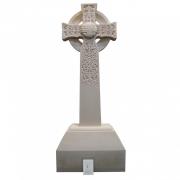 Many of the memorial wholesalers exhibiting at Tradex last year were keen to show the value they can add to memorials. They were encouraging memorial retailers to think beyond the black ogee top lawn memorial. Several companies showed memorials made from British stones, such as the Celtic Cross pictured left in Portland limestone on the J Rotherham stand. All J Rotherham’s memorials were made from British stones, which overcomes any concerns customers might have about slave or child labour in the supply chain. Ethical sourcing is a growing concern. As Hugo Were says: “Not everyone wants to bury Auntie Ethel under a chunk of India worked by slaves.” Hugo is from Welsh company Cerrig, which was also showing memorials made from British stones.
Many of the memorial wholesalers exhibiting at Tradex last year were keen to show the value they can add to memorials. They were encouraging memorial retailers to think beyond the black ogee top lawn memorial. Several companies showed memorials made from British stones, such as the Celtic Cross pictured left in Portland limestone on the J Rotherham stand. All J Rotherham’s memorials were made from British stones, which overcomes any concerns customers might have about slave or child labour in the supply chain. Ethical sourcing is a growing concern. As Hugo Were says: “Not everyone wants to bury Auntie Ethel under a chunk of India worked by slaves.” Hugo is from Welsh company Cerrig, which was also showing memorials made from British stones.
Another way to add value is with applied art and Alan Clough (pictured right), the Creative Supervisor at Odlings, spent Tradex on the wholesaler’s stand cutting Lady Elizabeth Butler’s painting Scotland Forever of a charge at Waterloo into black granite.
 Pictured left is a close-up of the Sprint engraver at work. It was introduced last year by The Blast Shop. It can transfer a photograph into an etching on stone, which is something an increasing number of people buying memorials find an attractive proposition. It is an easy way for a retailer to add value. And if you do not feel you are computer confident enough to turn a photograph into a program for the machine yourself, the American makers will do it for you for about $20 a time. You can currently buy the machine from The Blast Shop for £7,750. The diamond styluses that cut the stone last about nine months and cost £40.
Pictured left is a close-up of the Sprint engraver at work. It was introduced last year by The Blast Shop. It can transfer a photograph into an etching on stone, which is something an increasing number of people buying memorials find an attractive proposition. It is an easy way for a retailer to add value. And if you do not feel you are computer confident enough to turn a photograph into a program for the machine yourself, the American makers will do it for you for about $20 a time. You can currently buy the machine from The Blast Shop for £7,750. The diamond styluses that cut the stone last about nine months and cost £40.
Number of deaths goes back above 600,000
It looks as though the number of deaths in the UK last year edged back over the 600,000 threshold that it fell below in 2004 for the first time since 1957. Since 2004 it has consistently been below 600,000 in spite of the increasing population.
Although the government’s Office for National Statistics (ONS) publishes figures for the number of deaths in England and Wales weekly, monthly and quarterly, its annual figures take a long time to be released for the whole of the UK.
The ONS likes its annual reports to be complete, with causes of death, the age and sex of the deceased, broken down into regions (within England), unitary authorities, counties, districts and London boroughs, as well as England & Wales, Scotland and Northern Ireland.And as some inquests take more than a year from the time of death to be heard, the figures continue to amended for a long time.
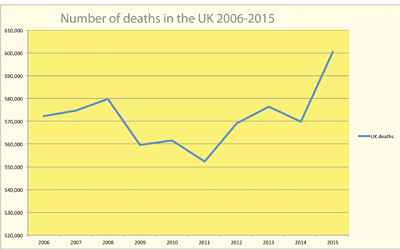
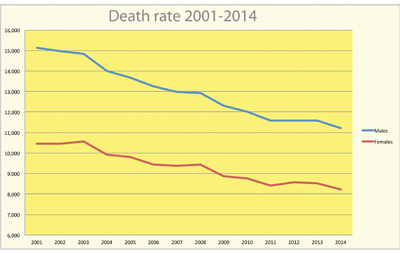
The figures used on the graphs here are from annual reports up to 2013 and are the sums of monthly reports for England & Wales for 2014 and 2015, extrapolated to include the rest of the UK. These are figures compiled by NSS and are not up to the rigorous standards of the ONS.
Nevertheless, they provide a guide to trends for the UK and are unlikely to be much different when the ONS publishes its final report. As England accounts for nearly 90% of the population of the UK, the England & Wales figures alone would be a good indication of trends throughout the UK.
The increase in deaths last year can be blamed squarely on a particularly nasty ‘flu virus that increased deaths by about 20% in the first quarter, mostly in January. Winter deaths were down again this year, although the growing population means that while the trend in the number of deaths is up, the trend in the death rate is still downwards.
 Computer program developer Mark Dewfield showed visitors to last year’s Tradex the new SAMM memorial management software from wholesaler George Willcox for its retailer customers. SAMM stands for Support Application for Memorial Masons. The program has developed a lot in conjunction with George Willcox customers in the past year – and the development is not over yet. SAMM is expected to be commercially launched later this year.
Computer program developer Mark Dewfield showed visitors to last year’s Tradex the new SAMM memorial management software from wholesaler George Willcox for its retailer customers. SAMM stands for Support Application for Memorial Masons. The program has developed a lot in conjunction with George Willcox customers in the past year – and the development is not over yet. SAMM is expected to be commercially launched later this year.
War memorials cleaned up for WWI commemorations
The centenary of the four years of World War I, which we are now half way through, have reminded communities of the significance of war memorials and all over the country they are being cleaned and renovated for commemorative events.
One of the people carrying out the work is Neal Everingham of memorial mason WP Everingham & Sons based in Hedon, in the East Riding of Yorkshire. Neal considers himself “lucky enough to have been born into a family of stonemasons”.
Cleaning stonework requires considerable expertise and a variety of techniques, but Neal has found steam cleaning invaluable in the work and the system he has chosen is Doff from Stonehealth.
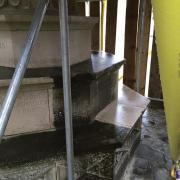 One of the war memorials recently cleaned by Neal’s company is the North Cave War Memorial pictured here. It is a Portland limestone column topped with an ornate cross and standing on an octagonal, tiered base with hand carved inscriptions commemorating various conflicts. You can see the difference Doff has made in the picture, with the work carried out conforming to the guidelines set out by the War Memorials Trust.
One of the war memorials recently cleaned by Neal’s company is the North Cave War Memorial pictured here. It is a Portland limestone column topped with an ornate cross and standing on an octagonal, tiered base with hand carved inscriptions commemorating various conflicts. You can see the difference Doff has made in the picture, with the work carried out conforming to the guidelines set out by the War Memorials Trust.
Neal says: “The Doff steam cleaner removes lichen and other organic dirt with high temperature steam rather than high pressure.” A pressure washer might have a nozzle exit pressure of hundreds of bar compared with the low effective nozzle pressure of just a few pounds per square inch (psi) of the Doff.
Neal: “On a headstone, a pressure washer would pull all the leaded lettering out as well as eating into the surface of the stone.”
To assist specifiers to identify genuine, trained, Doff contractors, Stonehealth has introduced its Rosette Scheme. This guarantees the equipment being used is Doff (or Torc, the gentle abrasive cleaning system from Stonehealth), that has been maintained with an annual service and is being used by a trained operator.
The conditions of the Rosette require contractors to provide written confirmation that the work has been carried out satisfactorily by named operators who carry a Stonehealth Rosette ID card.
It’s all change for memorial wholesaler A&J Robertson with new premises and a move into cremations
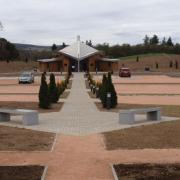 A&J Robertson (Granite) is one of the last granite companies in Aberdeen, which was once a centre of granite production and processing in Scotland with hundreds of companies involved. The company supplies memorials throughout the UK and was the last major UK memorial wholesaler to start importing and selling memorials from the Far East. Not that importing has brought production in Aberdeen to an end. Robertson still makes memorials at its factory, as it has since 1876, and it sells them, along with the imports, in its own chain of 30 memorial masons around the UK and to other retail memorial masons.
A&J Robertson (Granite) is one of the last granite companies in Aberdeen, which was once a centre of granite production and processing in Scotland with hundreds of companies involved. The company supplies memorials throughout the UK and was the last major UK memorial wholesaler to start importing and selling memorials from the Far East. Not that importing has brought production in Aberdeen to an end. Robertson still makes memorials at its factory, as it has since 1876, and it sells them, along with the imports, in its own chain of 30 memorial masons around the UK and to other retail memorial masons.
And it will continue to do so, although it is about to move out of its city centre factory and into premises once occupied by another stone company, Fyfe, at Westhill on the outskirts of the city. The new factory will be “split now” as Graeme Robertson describes it colloquially. That is, it will be state of the art and equipped with new machinery and handling equipment. The city centre site will be sold for development and the fireplace and stoves retail showroom currently there will be relocated centrally in Aberdeen.
At the same time, A&J Robertson has invested in a new crematorium that opened last month (May) at nearby Banchory. It is called Baldarroch and includes Bohus Grey granite signs and benches along with a variety of commemorative products supplied by A&J Robertson. Bohus Grey is a new stone from Sweden being supplied by Robertson, although it has sold Bohus Pink for granite memorials for some time. With cemeteries and crematoria being sold to private companies, Robertsons felt it was opportune to be involved with one, although Graeme says: “Owning cemeteries isn’t as easy as you might think.”

